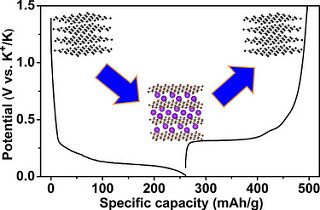The well-established scientific belief that potassium is incompatible with graphite for use in potassium-ion batteries has been disproved. This could pave the way for a sustainable replacement of lithium-ion batteries.
 This graphic outlines the electrical capacity of a newly developed potassium-ion battery. (Image courtesy of Oregon State University)
This graphic outlines the electrical capacity of a newly developed potassium-ion battery. (Image courtesy of Oregon State University)
Lithium-ion batteries are widely used including in gadgets, cell phones and electric cars. The new alternative, potassium-ion batteries, are likely to be cheaper and are made from materials that are available in abundance.
The team at Oregon State University (OSU) thinks that this discovery could pave the way for more alternatives to traditional batteries, which will be compatible with low-cost graphite as the anode or can be used with a high-energy reservoir of electrons.
Lithium can be used to generate current as it behaves as a charge carrier. In batteries lithium's ions travel towards the graphite anode depositing energy in the process. However, using lithium to facilitate current generation is expensive as lithium is rare. Only 0.0017% of the Earth's crust is made of lithium (by weight) resulting in its high price. This problem is not helped by lithiums low recyclability meaning most new batteries need new lithium to function.
For decades, people have assumed that potassium couldn’t work with graphite or other bulk carbon anodes in a battery. That assumption is incorrect. It’s really shocking that no one ever reported on this issue for 83 years.
Prof. Xiulei (David) Ji - Oregon State University
The use of easily available, and therefore less expensive, materials such as magnesium, potassium, or sodium to duplicate lithium’s performance is yet to happen.
The cost-related problems with lithium are sufficient that you won’t really gain much with economies of scale. With most products, as you make more of them, the cost goes down. With lithium the reverse may be true in the near future. So we have to find alternatives.
Prof. Xiulei (David) Ji - Oregon State University
Ji emphasized that potassium could well be the alternative, as the Earth’s crust contains 880 times more potassium than lithium. The latest research by OSU team proves that it is possible to use potassium with graphite or soft carbon in the anode of an electrochemical battery. Ji added that although the batteries made using potassium do not have the same performance of lithium-ion batteries as of yet, further research will soon close the gap.
It’s safe to say that the energy density of a potassium-ion battery may never exceed that of lithium-ion batteries. But they may provide a long cycling life, a high power density, a lot lower cost and be ready to take the advantage of the existing manufacturing processes of carbon anode materials
Prof. Xiulei (David) Ji - Oregon State University
The applications of electrical energy storage in batteries extend beyond consumer products such as, cell phones and laptops into transportation, micro-grid storage, industry power backup and renewable energy sectors.
Officials at OSU seek support to pursue this research to the next level and help market the innovative technology via the OSU Office of Commercialization and Corporate Development.
The primary research work is illustrated in The Journal of the American Chemical Society. The research received support from the U.S. Department of Energy and was performed in collaboration with other OSU researchers Zelang Jian and Wei Luo. The researchers await a patent for their novel technology.